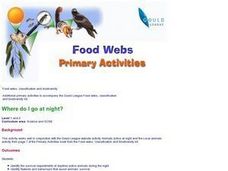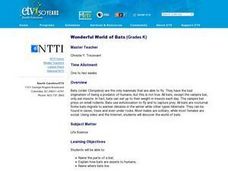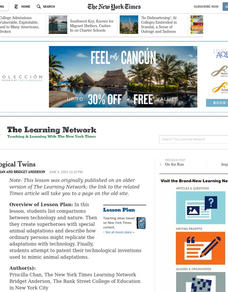Curated OER
Who's Hooting?
Young scholars in a special education class examine the nocturnal animals in their local area. Individually, they use the internet to research owls and share it with the class. To end the lesson, they use construction paper to make a...
Curated OER
Animals Active at Night
Students identify animals that are active at night and the reasons why. They examine the features needed to be a nocturnal animal. They create a representation of one of the animals.
Curated OER
Night Eyes
Fifth graders identify nocturnal animals based on specific characteristics. In this animals lesson, 5th graders observe an area at night using flashlights. Students record their findings and discuss as a group.
Curated OER
Who Goes There?
Learners discover behaviors of nocturnal animals. In this animal behavior lesson plan, students conduct a night time experiment with black light tracing materials to observe nocturnal animal behavior in the wild.
Curated OER
Guided Reading "In the Night Sky"
Students participate in a variety of reading exercises, such as choral reading and reading response journal, to reinforce concepts about space and nocturnal animals.
Curated OER
Where Do I Go At Night?
Learners describe the requirements of daytime and nightime animals for survival. They identify any behaviors that assist in the animal surviving. They create a representation for the class to view.
Curated OER
Sundials
Students investigate the different types of sundials and their history. In this shadows and time of day instructional activity students build their own sundials.
Curated OER
We Like to Imagine - Animals
Students describe a pretend animal. They read "The After School Monster." Students read other books and discuss whether or not the characters are real. Students make a drawing of a pretend animal and of a real animal. They make up a...
Bright Hub Education
All about Owls
Art projects are great ways to stimulate all the senses. Learners with visual impairments create art to better grasp the concept of day and night. They'll discuss the ways they know the difference in the time of day, the animals that are...
Curated OER
Wonderful World of Bats
Students create a book about bats. They write a letter to a scientist containing questions about bats. They compare the socialization of bats to humans; compare the needs of bats to humans and other animals.
Curated OER
Into the Bat Cave
Students explore the lives of bats. In this bat lesson plan, students participate in up 6 activities that focus on bats and build their background knowledge about the nocturnal mammals.
Curated OER
Learning About Mammals
Students study the mammal classification and forms of them living in the United States. In this mammal study lesson plan, students read through orders of mammals that exist in the United States. Students also study the taxonomy of an...
Curated OER
Technological Twins
Students list comparisons between technology and nature. Then they create superheroes with special animal characteristics and describe how ordinary persons might replicate the changes with technology.
Curated OER
We're Batty
Young scholars watch a video about bats and compare and contrast them to birds. They identify the specific characteristics that identify bats as mammals and what makes them unique from other mammals.
Curated OER
The Desert Biome
Students create a visual presentation of the characteristics of a biome. Working in small groups, students use traditional and online resources to gather data concerning biomes. Students use their information to create a bulletin board...
Other popular searches
- Owls and Nocturnal Animals
- Preschool Nocturnal Animals
- Nocturnal Animals Lessons
- Nocturnal Animals Songs
- Poems for Nocturnal Animals
- K Nocturnal Animals
- Pre K Nocturnal Animals
- List Nocturnal Animals
- Tracks of Nocturnal Animals
- Prue K Nocturnal Animals
- Iowa Nocturnal Animals
- Nocturnal Animals Projects
















